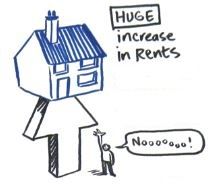Still Locked Out – Market Rents remain beyond HAP limits

The latest Locked Out of the Market Report from the Simon Communities of Ireland shows that, contrary to expectation and an increase in supply, the Covid-19 pandemic restrictions did not lead to a significant increase in affordability in the private rental market in 2020.
Locked Out of the Market is a quarterly report published by the Simon Communities of Ireland based on a snapshot survey conducted over three consecutive days. The latest version, published in January 2021, covers the three days of the 14th, 15th and 16th December 2020 and uses data from Daft.ie (an Irish property website that lists the asking prices for properties to both rental and buy) to track the number of properties advertised to rent that fall within Housing Assistance Payment (HAP) limits.
The Report found there were just 3,019 properties available to rent at any price within the 16 areas over the three dates surveyed, an increase of 19 per cent on the number available at the time of the previous Report in September 2020. Some 80 per cent of that increase in supply is mainly to be found in the Dublin area. Obviously measures implemented as a response to the pandemic, for example, a ban on evictions and rent increases, in addition to informal arrangements with landlords who don’t want to evict tenants in the middle of a health crisis will contribute to a lack of new properties on the market, however the number of rental properties available were declining in the years leading up to March 2020.
Of the total number of properties available to rent, less than two in five (1,160) were available within the standard or discretionary HAP limit in at least one of the four categories[1]. While this is more than double the number available within HAP limits in September 2020 (738), six of the 16 areas surveyed had no properties available for HAP tenants (Galway City Centre, Limerick City Suburbs, Limerick City Centre, Sligo Town, Portlaoise and Waterford City Centre.
For single-person households, just 4 properties (the Report refers to one-bedroom units) were within standard HAP limits across the 16 areas surveyed. When the discretionary increases to the HAP limits were applied[2], a further 95 properties match the availability criteria. To put this in context, almost half of all households on the social housing waiting lists in 2019[3] were single-person households (32,607, 47.5 per cent). Of these, 22,526 are within the Local Authority areas of the 16 areas selected by the Simon Communities for their survey.
For a couple with no children, 69 properties (one-bedroom units) were within standard limits with an extra 403 properties falling with the limit when the discretionary increase was applied. This means that only 15.6 per cent of all available properties are within the reach of a couple renting with the support of HAP. In 2019, there was a reported 2,984 couple households on the social housing waiting lists.
For a couple or lone parent with one child, 6 properties (2-bedroom units) were available within standard HAP limits with a further 562 properties becoming with reach when the discretionary extra was applied. That meant that just 18.8 per cent of the total properties were available within either HAP limit to this family type, increase from 14 per cent in September. In 2019, there was a reported 17,752 single-parent households on the social housing waiting lists.
For households consisting of a couple or lone parent with two children, there were just 14 properties (2 bedrooms or more) available within the standard HAP limit and a further 662 properties available within the discretionary HAP limits. For these family types, 22.3 per cent of all available properties were within the reach of their HAP allowance.
The Housing Assistance Payment is not delivering as a form of social housing support. It is not providing choice, security or affordability. The lack of availability means that either the tenant or Local Authority ends up paying more than expected, or allowed for, within their respective budgets. For those who cannot make up that difference, homelessness is the most likely outcome.
The private rented sector is not the solution to a public housing crisis. In fact, a 2019 Report by Focus Ireland found that 70 per cent of families accessing emergency accommodation in Dublin in 2019 came from the private rented sector. [4]
Rather than providing long-term social housing to households most in need, the Housing Assistance Payment is a subsidy to the private rented sector. We need to rethink our relationship with housing, particularly as part of our new Social Contract with the State. Social Justice Ireland again calls on Government to put a social housing target in place of 20 per cent of all housing stock by the year 2030.
[1] Single person; Couple; Couple/One Parent and One Child; and Couple/One Parent and Two Children.
[2] Local Authorities in the Dublin area have the discretion to increase the standard HAP rate by up to an additional 50 per cent and up to an extra 20 per cent of the standard rate elsewhere.
[3]SHA-Summary-2019-DEC-2019-WEB.pdf (housingagency.ie)
[4] https://www.focusireland.ie/press/focus-ireland-report-finds-that-nearly...